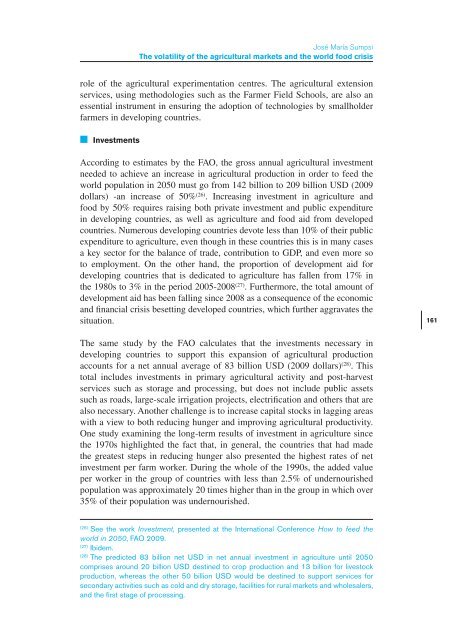Food security and global security - IEEE
Food security and global security - IEEE
Food security and global security - IEEE
- No tags were found...
You also want an ePaper? Increase the reach of your titles
YUMPU automatically turns print PDFs into web optimized ePapers that Google loves.
José María SumpsiThe volatility of the agricultural markets <strong>and</strong> the world food crisisrole of the agricultural experimentation centres. The agricultural extensionservices, using methodologies such as the Farmer Field Schools, are also anessential instrument in ensuring the adoption of technologies by smallholderfarmers in developing countries.■■InvestmentsAccording to estimates by the FAO, the gross annual agricultural investmentneeded to achieve an increase in agricultural production in order to feed theworld population in 2050 must go from 142 billion to 209 billion USD (2009dollars) -an increase of 50% (26) . Increasing investment in agriculture <strong>and</strong>food by 50% requires raising both private investment <strong>and</strong> public expenditurein developing countries, as well as agriculture <strong>and</strong> food aid from developedcountries. Numerous developing countries devote less than 10% of their publicexpenditure to agriculture, even though in these countries this is in many casesa key sector for the balance of trade, contribution to GDP, <strong>and</strong> even more soto employment. On the other h<strong>and</strong>, the proportion of development aid fordeveloping countries that is dedicated to agriculture has fallen from 17% inthe 1980s to 3% in the period 2005-2008 (27) . Furthermore, the total amount ofdevelopment aid has been falling since 2008 as a consequence of the economic<strong>and</strong> financial crisis besetting developed countries, which further aggravates thesituation.161The same study by the FAO calculates that the investments necessary indeveloping countries to support this expansion of agricultural productionaccounts for a net annual average of 83 billion USD (2009 dollars) (28) . Thistotal includes investments in primary agricultural activity <strong>and</strong> post-harvestservices such as storage <strong>and</strong> processing, but does not include public assetssuch as roads, large-scale irrigation projects, electrification <strong>and</strong> others that arealso necessary. Another challenge is to increase capital stocks in lagging areaswith a view to both reducing hunger <strong>and</strong> improving agricultural productivity.One study examining the long-term results of investment in agriculture sincethe 1970s highlighted the fact that, in general, the countries that had madethe greatest steps in reducing hunger also presented the highest rates of netinvestment per farm worker. During the whole of the 1990s, the added valueper worker in the group of countries with less than 2.5% of undernourishedpopulation was approximately 20 times higher than in the group in which over35% of their population was undernourished.(26)See the work Investment, presented at the International Conference How to feed theworld in 2050, FAO 2009.(27)Ibidem.(28)The predicted 83 billion net USD in net annual investment in agriculture until 2050comprises around 20 billion USD destined to crop production <strong>and</strong> 13 billion for livestockproduction, whereas the other 50 billion USD would be destined to support services forsecondary activities such as cold <strong>and</strong> dry storage, facilities for rural markets <strong>and</strong> wholesalers,<strong>and</strong> the first stage of processing.
















